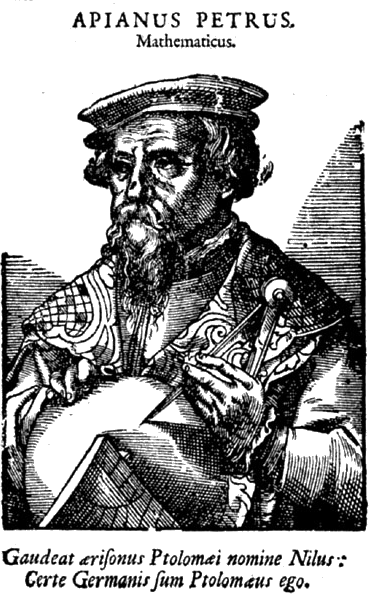<Back to Index>
- Astronomer Petrus Apianus, 1495
- Painter Frans van Mieris the Elder, 1635
- Social Reformer of Andhra Pradesh Kandukuri Veeresalingam, 1848
PAGE SPONSOR

Petrus
Apianus (April 16,
1495 – April 21, 1552), also known as Peter
Apian, was a German humanist,
known
for his works in mathematics, astronomy and cartography. The lunar
crater Apianus is named in his honour. He was
born as Peter Bienewitz (or Bennewitz)
in Leisnig in Saxony;
his
father was a shoemaker.
The
family was relatively well off, belonging to the middle class
citizenry of Leisnig. Apianus was educated at the Latin school in Rochlitz.
From
1516 to 1519 he studied at the University
of
Leipzig; during this time, he Latinized his name to Apianus (lat. apis means "bee"; "Biene" is the
German word for bee). In 1519,
Apianus moved to Vienna and continued his studies
at the University
of
Vienna, which was considered one of the leading universities in
geography and mathematics at the time and where Georg
Tannstetter taught.
When the plague broke out in Vienna in
1521, he completed his studies with a B.A. and moved to Regensburg and then to Landshut. In
Landshut, he produced his Cosmographicus
liber (1524), a
highly respected work on astronomy and navigation that was to see at least 30
reprints in 14 languages and that remained popular until the end of the
16th century. He married the daughter of a councilman of Landshut,
Katharina Mosner, in 1526. They would have 14 children together, five
girls and nine sons, one of which was Philipp
Apian. In 1527,
Peter Apian was called to the University of Ingolstadt as a mathematician and
printer. His print shop started small. Among the first books he printed
were the writings of Johann
Eck, Martin
Luther's antagonist. His print shop soon became well-known for its high-quality editions of geographic and cartographic works.
Through
his
work, Apian became a favourite of emperor Charles
V. Charles had praised his work (the Cosmographicus liber)
on
the Reichstag of 1530 and granted him a
printing monopoly in 1532 and 1534. In 1535, the emperor made Apian an armiger,
i.e., granted him the right to display a coat
of
arms. In 1540, Apian printed the Astronomicum
Caesareum,
dedicated to Charles V. Charles promised him a truly royal sum (3,000
golden guilders),
appointed
him his court mathematician, and made him a Reichsritter and in 1544 even a Hofpfalzgraf.
All
this furthered Apian's reputation as an eminent scientist.
Despite
many
calls from other universities, including Leipzig, Padua, Tübingen,
and Vienna,
Apian
remained in Ingolstadt until his death. Although he neglected his
teaching duties, the university evidently was proud to host such an
esteemed scientist. Apian's work included mathematics — in 1527 he
published a variation of Pascal's
triangle, and in 1534 a table of sines —
as well as astronomy. In 1531, he observed a comet and discovered that a
comet's tail always point away from the sun. (Girolamo
Fracastoro also
detected this in 1531, but Apian's publication was the first to also
include graphics.) He designed sundials,
published manuals for astronomical instruments and crafted volvelles
("Apian wheels"), measuring instruments useful for calculating time and
distance for astronomical and astrological applications.